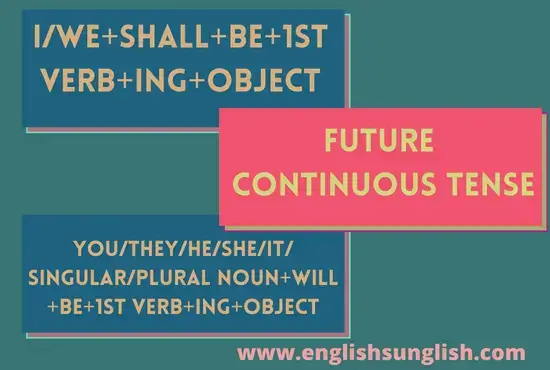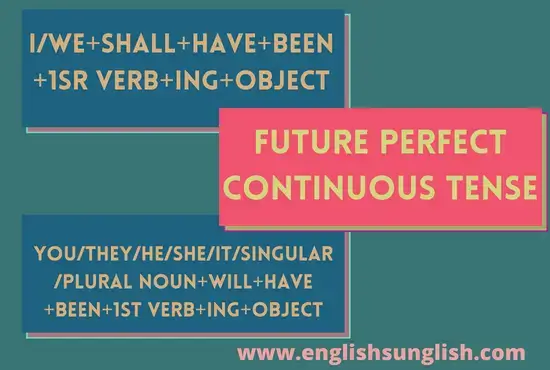Present Continuous Tense|Definition, rules, Formula, Examples
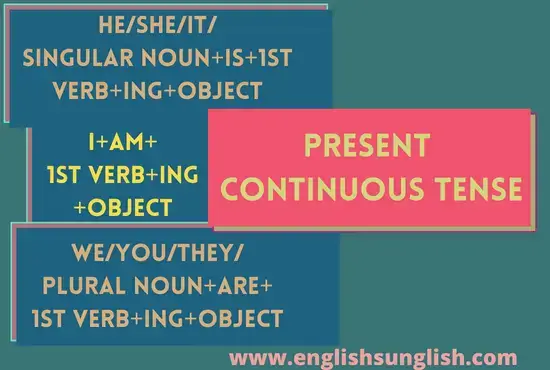
When the verb of a sentence shows an action as proceeding in the present period, then this sentence shows “Present Continuous Tense”. It means that the Present Continuous Tense shows an action when the action is continued and has not been completed yet. Some examples of Present Continuous Tense Sentences are as follow:
- I am speaking.
- You are speaking.
- He is speaking.
- We are speaking.
- They are speaking.
- She is waiting for you in the compound.
- I am hoping to get a holiday soon.
- The farmer is cutting the corn which has ripened.
Non-Continuous Verbs/ Non-Progressive Verbs
Some types of Verbs can never take the continuous form, so they can be used in Present Continuous Tense in their original form, without the addition of “ing” to their 1st form of Verb. The following article has the list of these non-continuous verbs:
Helping Verbs used in Present Continuous Tense
Present Continuous Tense uses the following 3 helping verbs to express the progressing actions/activities. All of the thrice is used with the specific pronouns and the specific number of nouns.
“Is” as a Helping verb in the Present Continuous Tense
“Is” is used as a helping verb in the Present Continuous Tense with the singular number of nouns and with the following single-person pronouns:
- He
- She
- It

“Are” as Helping Verb in the Present Continuous Tense
“Are” is used as a helping verb in Present Continuous Tense with the plural number of nouns and with the following plural person pronouns:
- You
- We
- They
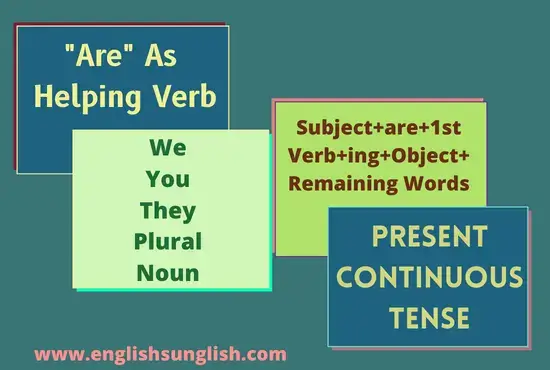
“Am” as Helping Verb in Present Continuous Tense
“Am” is used as a helping verb in the Present Continuous Tense, when a person talks about himself.
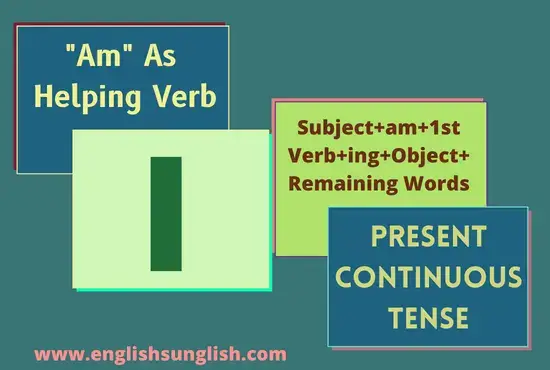
Sentence Structure of Present Continuous Tense
The Assertive, Negative, Interrogative, and Negative-Interrogative Sentences of the Present Continuous Tense have the following sentence structure.
Assertive Sentence Structure of Present Continuous Tense
Present Continuous Tense uses “is/are/am” as a helping verb to show the continuous/progressing actions and states. 1st form of the verb with the addition of “ing” is used with the helping verbs in the Present Continuous Tense.
The helping verb “is” can be used with the singular number of nouns and with single-person pronouns “he, she, it”. So, the Assertive Sentence Structure of Present Continuous Tense with “is” has the following “subject, object, verb” agreement.
Subject+ is+ 1st form of Verb+ ing+ Object+ Remaining Words
“Are” can be used as a helping verb in Present Continuous Tense with a plural number of nouns and with the pronouns “you, they, we”. The Assertive Sentence Structure of Present Continuous Tense with “is” has the following “subject, object, verb” agreement.
Subject+ are+ 1st form of Verb+ ing+ Object+ Remaining Words
“Am” is used as a helping Verb in the Present Continuous Tense with only one pronoun “I”. It means that “am” is used in the Present Continuous Tense when one is telling about his continuous activity or state. The Assertive Sentence Structure of the Present Continuous Tense with “am”, is as follows.
Subject+ am+ 1st form of Verb+ ing+ Object+ Remaining Words
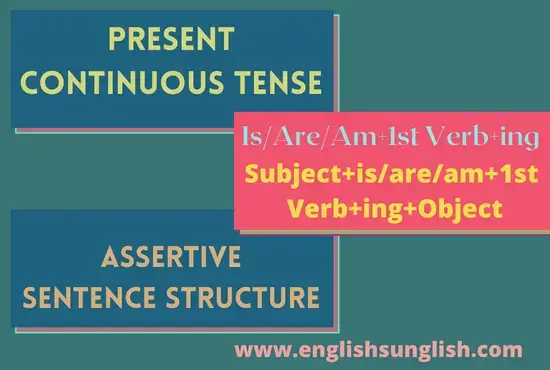
Examples of Assertive Sentences of Present Continuous Tense
Following are some examples of Assertive Sentences of Present Continuous Tense.
Is
The helping verb “is” can be used with the singular number of nouns and with single person pronouns “he, she, it” and such sentences of Present Continuous Tense with helping verb “is”, have the following agreement of subject, object, and verb. Following are some examples of Assertive Sentences of Present Continuous Tense.
Subject+ is+ 1st form of Verb+ ing+ Object+ Remaining Words
- The boy is preparing well for the examination.
- The hen is laying eggs.
- The milkman is milking.
- He is going.
- It is raining.
- The carpenter is making a table.
- The ship is going.
- The washer-woman is washing the clothes.
- Karim is learning his lesson.
- The peacock is dancing.
- The cat is meowing.
- The crow is crowing.
- The lion is roaring.
- John is writing a letter.
- David is sleeping.
- The dog is barking.
- She is plucking the flowers.
- I am taking a cup of tea.
- He is driving a car.
- Amjad is winding the watch.
- The cloth is selling cheap.
- The rich man is giving alms.
- The beggar is counting coins.
- He is turning the tap on.
- It is drizzling.
- The Persian wheel is working.
- Smoke is rising out of the hearth.
- He is diving into the river.
- Akbar is harvesting wheat.
- The woman is boiling milk.
- He is coming to see me.
- The government is opening new schools.
- India/Pakistan is making progress by leaps and bounds.
Are
“Are” can be used as a helping verb in Present Continuous Tense with a plural number of nouns and with the pronouns “you, they, we”. Following are some examples of Assertive Sentences of Present Continuous Tense with the helping verb “are”.
Subject+ are+ 1st form of Verb+ ing+ Object+ Remaining Words
- People are going to Alpha Park for a picnic.
- The boys are throwing stones at the frogs.
- My friends are encouraging me.
- The fisherman is catching fish.
- The police are running after the murderer.
- We are printing a new book.
- We are collecting old coins.
- You are saying goodbye to your friend.
- Children are making a great noise.
- Students are decorating the school.
- They are going.
- We are reading.
- The girls are singing.
- The children are playing.
- We are learning our lessons.
- The boys are playing in the garden.
- The boys are drawing the map of Pakistan.
- The women are drawing water from the well.
- The cows are grazing in the field.
- We are sitting on the floor.
- The birds are singing.
- The boys are taking exercise in the garden.
- They are running.
- They are rowing the boat.
- The boys are playing cricket.
Am
“Am” is used as a helping Verb in the Present Continuous Tense with only one pronoun “I”. Following are some examples of Assertive Sentences of Present Continuous Tense with the helping verb “am”.
Subject+ am+ 1st form of Verb+ ing+ Object+ Remaining Words
- I am making a map of Pakistan.
- I am looking for my watch.
- I am taking a rest at this time.
- I am feeling dizzy.
- I am driving the car.
- I am taking tea.
- I am playing cricket in the garden.
- I am sleeping.
- I am learning my lesson.
- I am reading the book.
- I am running in the garden.
- I am plucking the flowers.
- I am writing a letter to my brother.
- I am singing this song.
Negative Sentence Structure of Present Continuous Tense
The Negative Sentences of the Present Continuous Tense take “is/are/am” with “not” to show the negativity of the progressing actions or states.
The Negative Sentences of the Present Continuous Tense use the helping verb “is not”, with the singular number of nouns and with single person pronouns “he, she, it” and have the following subject, object, and verb agreement.
Subject+ is+ not+ 1st form of Verb+ ing+ Object+ Remaining Words
The Negative Sentences of the Present Continuous Tense with a plural number of nouns and with plural person pronouns “we, you, they”, use the helping verb “are not “. The Negative Sentences of Present Continuous Tense has the following agreement of subject, object, and verb.
Subject+ are+ not+ 1st form of Verb+ ing+ Object+ Remaining Words
The Negative Sentences of Present Continuous Tense take “am not” with only one pronoun “I”. It means that when a person telling about his negative progressing action, then “am not” is used. The Negative Sentences with “am not” has the following subject, object, and verb agreement.
Subject+ am+ not+ 1st form of Verb+ ing+ Object+ Remaining Words
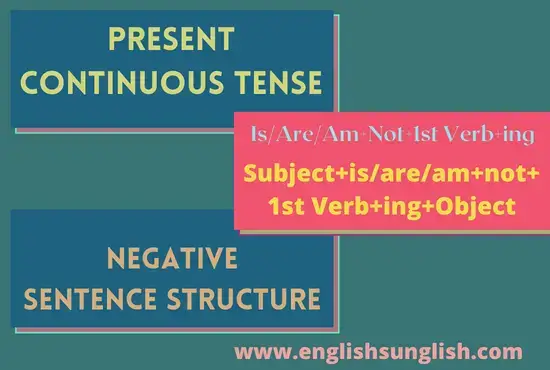
Examples of Negative Sentences of Present Continuous Tense
Following are some examples of the Negative Sentences of Present Continuous Tense.
Is+not
The Negative Sentences of the Present Continuous Tense use the helping verb “is not”, with a singular number of nouns and with single person pronouns “he, she, it”. Following are some examples of negative sentences with the helping verb “is not”.
Subject+ is+ not+ 1st form of Verb+ ing+ Object+ Remaining Words
- The bus is not coming this way.
- She is not smiling.
- The nobleman is not looking down upon you.
- He is not facing the danger bravely.
- The driver is not driving the car fast.
- He is not leading the procession.
- The Governor is not presiding over the meeting.
- He is not working honestly.
- The officer is not neglecting his duties.
- He is not repenting of his sin.
- The cook is not preparing a meal.
- The woman is not calling for help.
- John is not changing his dress.
- The woman is not working grindstone.
- He is not singing.
- The girl is not singing.
- He is not reading.
- He is not doing his duty.
- John is not writing the letter.
- David is not going to his home.
- The tailor is not sewing my clothes.
- It is not raining.
- Marry is not washing the clothes.
- The farmer is not plowing in the fields.
- The peon is not ringing the bell.
Are+not
The Negative Sentences of the Present Continuous Tense with a plural number of nouns and with plural person pronouns “we, you, they”, use the helping verb “are not “. Following are some examples of negative sentences of Present Continuous Tense with the helping verb “are not”.
Subject+ are+ not+ 1st form of Verb+ ing+ Object+ Remaining Words
- People are not going to the airport.
- Children are not making mischief.
- We are not waiting for anyone.
- The dogs are not fighting over the bone.
- We are not dividing the property.
- You are not cooperating with your friend.
- Children are not catching butterflies.
- You are not giving me your address.
- You are not criticizing my opinion.
- The laborers are not shirking work.
- We are not smelling flowers.
- The girls are not dancing in the class.
- The boys are not drinking sugarcane juice.
- They are not playing football.
- You are not doing your work.
- They are not reading the book.
- They are not plucking the flowers.
Am+not
The Negative Sentences of Present Continuous Tense take “am not” with only one pronoun “I”. It means that when a person tells about his negative progressing actions, then “am not” is used. Following are some examples of Negative Sentences with the helping verb “am not”.
Subject+ am+ not+ 1st form of Verb+ ing+ Object+ Remaining Words
- I am not telling him the secret.
- I am not milking the goat.
- I am not wasting time.
- I am not singing the songs.
- I am not learning my lesson.
- I am not representing them.
- I am not making a noise.
- I am not chasing her.
- I am not taking much interest in winning first prize.
- I am not sewing her shirt.
- I am not cleaning the cupboard.
Interrogative Sentence Structure of Present Continuous Tense
Present Continuous Tense uses “is/are/am” at the start of the sentences to make the Interrogative Sentences.
However, the Interrogative Sentences with the Words of Questions (what, when, where, etc;) has “is/are/am” after them and have the following agreement of the word of the question, subject, object, and verb.
Word of Question+ is/are/am+ Subject+ 1st form of Verb+ ing+ Object+ Remaining Words+ ?
Interrogative Sentences of Present Continuous Tense use “is” at the start of the sentences with a singular number of nouns and with single person pronouns “he, she, it”. The Interrogative Sentences of Present Continuous Tense with the helping verb “is” has the following subject, object, and verb agreement.
Is+ Subject+ 1st form of Verb+ ing+ Object+ Remaining Words+ ?
Interrogative Sentences of Present Continuous Tense use “are” at the start of the sentences with a plural number of nouns and with plural person pronouns “we, you, they”. The Interrogative Sentences of Present Continuous Tense with the helping verb “are” has the following subject, object, and verb agreement.
Are+ Subject+ 1st form of Verb+ ing+ Object+ Remaining Words+ ?
Interrogative Sentences of Present Continuous Tense use “am” at the start of the sentences only with one pronoun “I”, when a person tells about his progressing actions. The Interrogative Sentences of Present Continuous Tense with the helping verb “am” has the following subject, object, and verb agreement.
Am+ Subject+ 1st form of Verb+ ing+ Object+ Remaining Words+ ?

Examples of Interrogative Sentences of Present Continuous Tense
Following are some examples of Interrogative Sentences of Present Continuous Tense.
Word of Question+is/are/am+?
The Interrogative Sentences that have the Word of Question at the start, use “is/are/am” after them to ask a question and have a following arrangement of the subject, object, and verb. For example:
Word of Question+ is/are/am+ Subject+ 1st form of Verb+ ing+ Object+ Remaining Words+ ?
- Where are the people dancing?
- Why are the students coming back early from school?
- Why is the plane landing here?
- Who is ringing the bell?
- When are the guests arriving here?
- How many persons are considering this matter?
- Who is the nurse talking to?
- How is the doctor giving an injection to the patient?
- How many lawyers are discussing it?
- Why are you selling your house?
- Where are women washing clothes?
- How many people are sharing this business?
- How much money are you withdrawing from the bank?
- Who is inviting me to supper?
- Where are the poor refugees going?
- Whose message are you carrying?
- When is the contractor setting to work?
- Who is knocking at the door?
- Which magazine are you reading?
Is+?
“Is” comes at the start of the Interrogative Sentences that have the singular number nouns or the single person pronouns “he, she, it”. The Interrogative Sentences with the helping verb “is” has the following arrangement of the subject, object, and verb.
Is+ Subject+ 1st form of Verb+ ing+ Object+ Remaining Words+ ?
- Is the baby sleeping?
- Is Salma going to her aunt’s house?
- Is your watch losing five minutes daily?
- Is the moon appearing?
- Is the shopkeeper overcharging the customer?
- Is Arif writing a letter?
- Is David buying a new car?
- Is the teacher teaching?
- Is Akbar working?
- Is David going to his home?
- Is the tailor sewing my clothes?
- Is it raining?
- Is Marry washing her clothes?
- Is the farmer plowing in the fields?
- Is peon ringing the bell?
- Is she telling a lie?
- Is Henry buying a new motorcycle?
- Is the shopkeeper overcharging the customer?
Are+?
The plural number nouns and plural person pronouns “you, we, they”, use “are” at the start of the Interrogative Sentences to ask questions. Such Interrogative Sentences have the following subject, object, and verb arrangement within the Interrogative Sentences.
Are+ Subject+ 1st form of Verb+ ing+ Object+ Remaining Words+ ?
- Are you listening to the news?
- Are the players playing the match?
- Are the bad boys throwing stones at buses?
- Are the laborers digging soil?
- Are they playing football?
- Are you working on this project?
- Are they learning their lesson by heart?
- Are they plucking the flowers?
- Are you giving me your address?
- Are you criticizing my opinion?
- Are the laborers shirking their work?
- Are we smelling flowers?
- Are the girls dozing in the class?
- Are the boys drinking the orange juice?
Am+?
“Am” comes at the start of the Interrogative Sentences of the Present Continuous Tense with only one pronoun “I” and such Interrogative Sentences of the Present Continuous Tense have the following subject, object, and verb agreement.
Am+ Subject+ 1st form of Verb+ ing+ Object+ Remaining Words+ ?
- Am I addressing you?
- Am I combing my hair?
- Am I feeling sleepy?
- Am I taking a rest at this time?
- Am I feeling dizzy?
- Am I throwing stones at the bus?
- Am I digging the soil?
- Am I buying a new house?
- Am I overcharging the customers?
- Am I drinking mango juice?
- Am I dozing in class?
- Am I calling for that man?
Negative Interrogative Sentence Structure of Present Continuous Tense
Negative Interrogative Sentences of the Present Continuous Tense is telling about some negative-question about some progressing actions or states.
“Is/are/am” comes after the Word of Question with such Negative-Interrogative Sentences of Present Continuous Tense that have the Word of Question at their start and “not” comes after the subject of the sentence. The Negative Interrogative Sentences with Words of Question have the following subject, object, and verb agreement.
Word of Question+ is/are/am+ Subject+ not+ 1st form of Verb+ ing+ Object+ Remaining Words+ ?
The Negative-Interrogative Sentences of Present Continuous Tense have the following arrangement of Subject, Object and Verb with singular number nouns and with single person pronouns (he, she, it).
Is+ Subject+ not+ 1st form of Verb+ ing+ Object+ Remaining Words+ ?
Plural Number Nouns and plural person pronouns take “are” at the start of the Negative Interrogative Sentences to ask a question and “not” comes after the subject of the Negative Interrogative Sentence of the Present Continuous Tense. Here, is the subject, object, and verb agreement of Negative Interrogative Sentences:
Are+ Subject+ not+ 1st form of Verb+ ing+ Object+ Remaining Words+ ?
“Am” comes at the start of the Negative Interrogative Sentences that have the “I” pronoun as their subject. And “not” comes after the subject of the Negative Interrogative Sentences to show the negativity of the question. Such sentences of Negative Interrogative Sentences have the following arrangement of the subject, object, and verb within the sentence.
Am+ Subject+ not+ 1st form of Verb+ ing+ Object+ Remaing Words+ ?
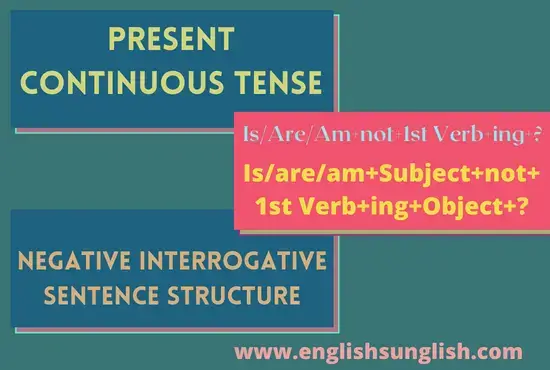
Examples of Negative Interrogative Sentences of Present Continuous Tense
Following are some examples of Negative Interrogative Sentences of Present Continuous Tense.
Word of Question+is/are/am+not+?
“Is/are/am” comes after the Word of Question with such Negative-Interrogative Sentences of Present Continuous Tense that have the Word of Question at their start and “not” comes after the subject of the sentence. The Negative Interrogative Sentences with Words of Question have the following subject, object, and verb agreement.
Word of Question+ is/are/am+ Subject+ not+ 1st form of Verb+ ing+ Object+ Remaining Words+ ?
- Where are the people not dancing?
- Why are the students not coming back early from school?
- Why is the plane not landing here?
- Who is not ringing the bell?
- When are the guests not arriving here?
- How many people are not considering this matter?
- Who is the nurse not talking to?
- How is the doctor not giving an injection to the patient?
- How many lawyers are not discussing it?
- Why are you not selling your house?
- Where are women not washing clothes?
- How many people are not sharing the business?
- How much money are you not withdrawing from the bank?
- Who is not inviting me to supper?
- Why are the poor refugees not going from here?
- Whose message are you not carrying?
- When is the contractor not set to work?
- Who is not knocking at the door?
- Which magazine are you not reading?
Is+not+?
The Negative-Interrogative Sentences of Present Continuous Tense have the following arrangement of Subject, Object and Verb with singular number nouns and with single person pronouns (he, she, it).
Is+ Subject+ not+ 1st form of Verb+ ing+ Object+ Remaining Words+ ?
- Is the baby not sleeping?
- Is Salma not going to her aunt’s house?
- Is your watch not losing five minutes daily?
- Is the moon not appearing?
- Is the shopkeeper not overcharging the customer?
- Is Arif not writing a letter?
- Is David not buying a new car?
- Is the teacher not teaching?
- Is Akbar not working?
- Is David not going to his home?
- Is the tailor not sewing my clothes?
- Is it not raining?
- Is Marry not washing her clothes?
- Is the farmer not plowing in the fields?
- Is peon not ringing the bell?
- Is she not telling a lie?
- Is Henry not buying a new motorcycle?
- Is the shopkeeper not overcharging the customer?
Are+not+?
Plural Number Nouns and plural person pronouns take “are” at the start of the Negative Interrogative Sentences to ask a question and “not” comes after the subject of the Negative Interrogative Sentences of the Present Continuous Tense. Here, is the subject, object, and verb agreement of Negative Interrogative Sentences:
Are+ Subject+ not+ 1st form of Verb+ ing+ Object+ Remaining Words+ ?
- Are you not listening to the news?
- Are the players not playing the match?
- Are the bad boys not throwing stones at buses?
- Are the laborers not digging soil?
- Are they not playing football?
- Are you not working on this project?
- Are they not learning their lesson by heart?
- Are they not plucking the flowers?
- Are you not giving me your address?
- Are you not criticizing my opinion?
- Are the laborers not shirking their work?
- Are we not smelling flowers?
- Are the girls not dozing in the class?
- Are the boys not drinking the orange juice?
Am+not+?
“Am” comes at the start of the Negative Interrogative Sentences that have the “I” pronoun as their subject. And “not” comes after the subject of the Negative Interrogative Sentences to show the negativity of the question. Such sentences of Negative Interrogative Sentences have the following arrangement of the subject, object, and verb within the sentence.
Am+ Subject+ not+ 1st form of Verb+ ing+ Object+ Remaing Words+ ?
- Am I not addressing you?
- Am I not combing my hair?
- Am I not feeling sleepy?
- Am I not taking a rest at this time?
- Am I not feeling dizzy?
- Am I not throwing stones at the bus?
- Am I not digging the soil?
- Am I not buying a new house?
- Am I not overcharging the customers?
- Am I not drinking mango juice?
- Am I not dozing in class?
- Am I not calling for that man?
Passive Voice of Present Continuous Tense
Passive Voice of Present Continuous tense can be made by following the:
